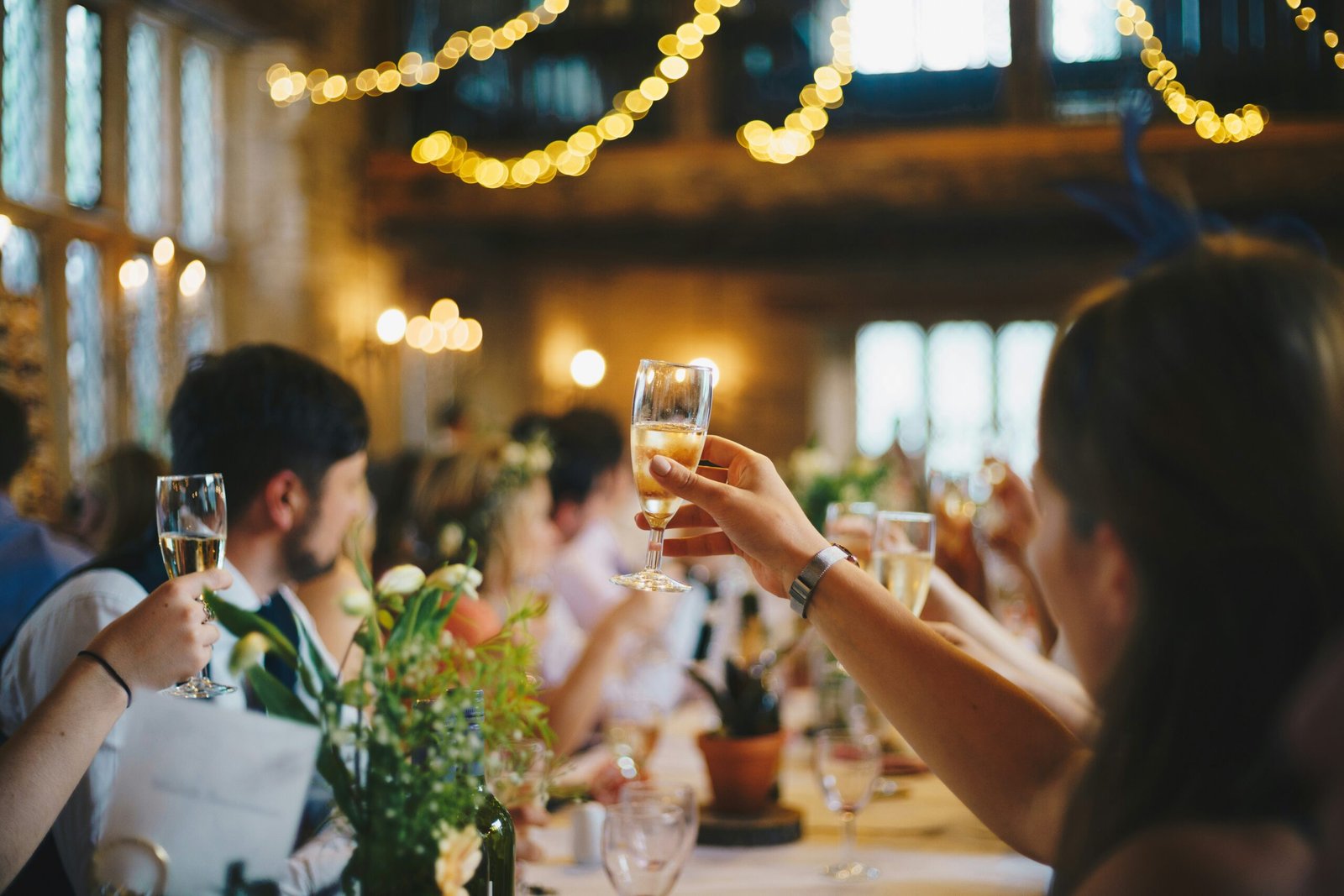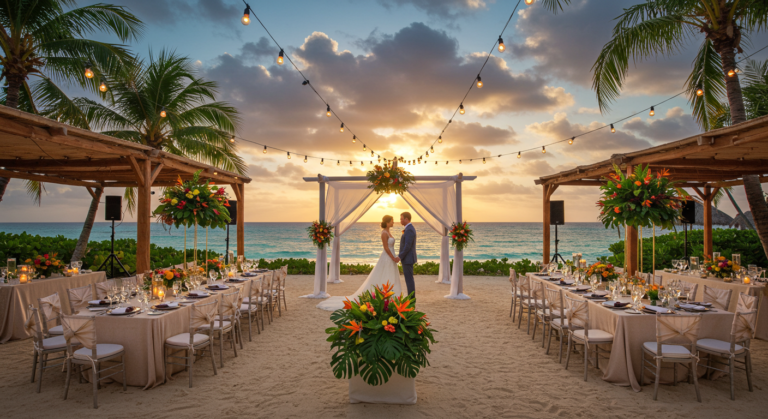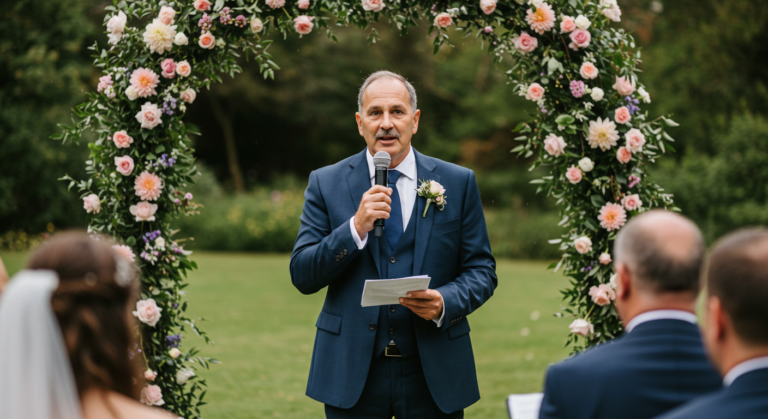Creating a Memorable Wedding Reception Table Layout

The Significance of Table Layout in Wedding Receptions
A meticulously crafted table layout is a fundamental element in ensuring a successful wedding reception. The arrangement of tables and seating plays a critical role in shaping the overall atmosphere of the event, influencing guest interactions and their enjoyment throughout the celebration. When guests feel comfortable and welcomed, they are more likely to engage positively with one another, providing an enjoyable experience that resonates long after the event has concluded.
The configuration of the tables can significantly affect how guests socialize and connect during the reception. For instance, placing tables in circular arrangements encourages mingling, fostering an inclusive environment. Alternatively, long banquet-style tables can create a sense of unity among guests, perfect for larger gatherings. Thoughtful consideration of both the physical layout and the dynamics of your guest list can foster an environment that encourages connection and conversation, enhancing the overall enjoyment of the celebration.
Furthermore, a well-designed table layout reflects the couple’s personal style and sets the mood for the entire event. Couples who wish to exhibit a romantic ambiance might opt for elegantly draped tables adorned with soft lighting, creating an intimate atmosphere. In contrast, a modern wedding might showcase sleek lines and contemporary décor. The table layout serves as both a functional and aesthetic component of the reception, allowing the couple to articulate their vision and theme effectively.
Examples of how layout reinforces the theme of the wedding are abundant. A rustic wedding could feature long farm tables set under a canopy of string lights, while a formal evening wedding might incorporate round tables with elegant linens and crystal centerpieces. Ultimately, the importance of a well-planned table layout cannot be overstated, as it serves to enhance guest interactions, influence the overall mood, and provide a reflection of the couple’s unique style, making the wedding reception truly memorable.
Choosing the Right Shape for Your Tables
When planning a wedding reception, the choice of table shape plays a crucial role in establishing the atmosphere and facilitating interactions among guests. The main types of table shapes include round, square, rectangular, and long banquet tables, each with its own distinct advantages and disadvantages.
Round tables are a popular choice, as they promote a sense of intimacy and encourage conversation. They allow for easy access to food and refreshments, making them ideal for large gatherings. Typically seating 8 to 10 guests, round tables can create a cozy environment. However, they may require more space compared to other shapes, which could be a limitation in smaller venues.
Square tables offer a modern aesthetic and can be arranged in various configurations. They are often used to create a unique layout, allowing guests to engage with each other more easily. Although they may not be as space-efficient in terms of seating as round tables, they can provide a contemporary look that complements certain wedding themes. One drawback is that they can sometimes lead to groups of guests feeling isolated at a larger event.
Rectangular tables are versatile and can be easily aligned to fill the space available in the venue. They are particularly beneficial for longer guest lists, allowing for a more extensive social area. However, depending on the size, conversation can be challenging across the table’s length, which might create a less intimate experience for guests seated at opposite ends.
Long banquet tables, similar to rectangular tables, are ideal for family-style dining and orchestrating a more communal feel. They can be adorned with elaborate centerpieces, which enhance aesthetic appeal. However, seating arrangements require careful consideration to promote conversation flow. Ultimately, choosing the right table shape depends on the venue size, guest list, and overall wedding theme, ensuring a memorable experience for all attendees.
Understanding Guest Dynamics: Who Should Sit Where
When planning a wedding reception, the significance of guest dynamics cannot be overstated. The arrangement of guests at the tables greatly influences the overall atmosphere and enjoyment of the event. Thoughtful seating strategies can foster interaction, comfort, and a memorable experience for all attendees. One key aspect to consider is grouping guests based on their relationships. By seating family members and close friends together, couples can create an environment where conversations flow freely and connections are strengthened.
Additionally, it is essential to be mindful of any potential conflicts when organizing the seating chart. This involves considering past relationships or disagreements that may exist among guests. Placing guests who may not see eye to eye at separate tables can help maintain a harmonious atmosphere during the reception. Furthermore, to promote inclusivity, it is beneficial to mix guests from different social circles. This encourages diverse interactions and helps everyone feel part of the celebration.
Creating a seating chart offers distinct advantages compared to open seating. A well-planned seating arrangement can reduce anxiety for guests, as finding their assigned seats eliminates the awkwardness of searching for a place. Additionally, it allows hosts to curate a blend of personalities, ensuring that guests share tables with individuals with whom they may connect well. In contrast, open seating may lead to unbalanced tables where some individuals may feel left out while others dominate conversations.
In conclusion, understanding guest dynamics is crucial to the successful organization of a wedding reception. By implementing strategic seating arrangements that thoughtfully consider relationships, manage potential conflicts, and utilize the benefits of a seating chart, couples can create a comfortable and enjoyable atmosphere for all their guests. This careful planning fosters a memorable celebration that reflects the love and joy of the couple’s union.
Creating Focal Points with Centerpieces and Decor
In designing a memorable wedding reception table layout, centerpieces and decor play a pivotal role in establishing visual interest and creating an inviting atmosphere. A well-chosen centerpiece can serve as a focal point, reflecting the couple’s personality and the overarching theme of the wedding. It is essential to select unique centerpieces that not only complement the table settings but also offer a glimpse into the couple’s story and preferences.
When contemplating centerpieces, consider a variety of elements such as height, color, and shape. Taller arrangements can create an elegant vertical dimension, while lower pieces encourage interaction among guests. For instance, if the wedding’s theme includes rustic elements, opting for wooden crates filled with seasonal flowers can add both charm and theme coherence. Conversely, sleek glass vases with minimalist floral arrangements may suit a modern aesthetic well. Mixing different heights within your centerpieces can add depth and visual complexity, enhancing the overall look without overwhelming the table.
Aesthetical arrangement is paramount; ensure that decorations are strategically placed to draw the eye but do not obstruct the conversation. It is vital that guests can see each other across the table, fostering interaction and engagement. Utilizing decorators’ tips, such as placing candles or smaller decorative items alongside larger centerpieces, can create a balanced look, encouraging guests to appreciate all elements of the table display. Additionally, utilizing linens that contrast with the decor can make every centerpiece pop, creating an unforgettable presentation.
Ultimately, the goal is to curate a visually stunning ensemble that enhances the ambiance while considering the practical elements necessary for guest comfort. Thoughtfully arranged centerpieces can transform an ordinary table into a captivating focal point for any wedding celebration.
Incorporating Personal Touches into the Table Layout
Creating a memorable wedding reception requires careful attention to detail, particularly when it comes to the table layout. One of the most impactful ways to personalize this aspect of your wedding is through the use of personalized elements. For instance, personalized place cards can enhance the dining experience by making each guest feel uniquely valued. These can range from elegantly designed cards featuring the guest’s name to fun, handwritten notes that reflect the couple’s personality or relationship journey.
Another innovative idea to consider is theming your table names. Rather than using numbers, couples can select names that hold meaning for them—such as locations they have visited together, favorite songs, or shared interests. By allowing each table to tell a part of your love story, you take an ordinary reception experience and transform it into a reflective journey for your guests. This also provides an excellent conversation starter among guests, further fostering a warm and engaging atmosphere.
Custom table linens are another great avenue for adding personal flair. Choosing fabrics or patterns that resonate with your color scheme or reflect your personal style can make a significant difference. Whether it is a vintage lace overlay or vibrant, modern colors, custom linens create a cohesive look that aligns more closely with the couple’s vision. Additionally, unique dishware can elevate the dining experience. Opting for mismatched vintage plates or custom-printed dinnerware can infuse a distinctive charm into your reception.
Lastly, couples should take the time to reflect on their own story or shared interests when designing their table arrangements. By thoughtfully incorporating elements that are meaningful to them, they can create an atmosphere that invites guests to participate in their celebration. This personalization not only adds aesthetic appeal but also fosters an intimate connection amongst all who attend.
Practical Considerations: Space and Logistics
When planning a wedding reception, understanding the practical considerations of space and logistics is paramount. The size of the venue will directly influence the table layout, as well as the overall guest experience. Venues come in various shapes and sizes, so it is essential to assess the physical dimensions to ensure adequate space for seating while maintaining ease of movement for guests and staff alike.
One fundamental aspect is the determination of the number of guests. A well-calibrated seating arrangement can facilitate better interaction among attendees and contribute to a more enjoyable atmosphere. Aim for approximately 60 to 72 inches of table space per guest to guarantee comfort. The optimal distance between tables should allow guests to engage comfortably without feeling cramped. A space of about 5 to 6 feet between tables can promote easy navigation, while also enabling server access during meal service.
Consideration for additional activities, such as dancing or speeches, is another critical factor. It is advisable to ensure that dance floor areas are clearly defined and separate from seated areas to avoid congestion. This aids in attracting guests to participate in various activities without feeling blocked or constrained. Notably, if the venue permits, utilizing a flexible layout that allows for future adjustments will create a more dynamic reception space. As plans evolve, the ability to modify arrangements can accommodate for last-minute changes in guest attendance or evolving event logistics.
By thoughtfully addressing these practical aspects, planners can create a functional table layout that prioritizes the comfort and enjoyment of guests while enhancing the overall flow of the wedding reception.
Creating Ambiance with Lighting and Table Settings
Establishing a captivating ambiance for a wedding reception is crucial, as it sets the tone for the entire event. One of the most effective ways to achieve this is through the strategic use of lighting. Uplighting, for example, involves placing lights on the ground and directing them upwards against walls or structures to create soft, enchanting washes of color. This technique can highlight specific features of the venue while also enriching the emotional atmosphere. When selecting colors for uplighting, consider the wedding theme; subtle pastels may evoke a romantic feeling, while vibrant hues can energize the space.
In addition to uplighting, fairy lights can add a whimsical element to the reception. Draping these delicate twinkling lights across beams, tables, or around dance floors can instill a sense of magic, transforming ordinary spaces into unforgettable experiences. Consider integrating them into floral arrangements or chandeliers for an extra touch of charm. Complementing fairy lights with candles can further enhance the ambiance, as their flickering flames create a warm and intimate setting. Votive candles, tea lights, or elegant candelabras can serve both functional and decorative purposes, providing intimate illumination while reflecting the couple’s style.
The table settings play a vital role in fortifying the overall theme, as they serve as the invitation to your guests’ experience. Coordinating colors and styles is essential; select tableware that harmonizes with your chosen color palette. Elegant china, textured table linens, and thoughtfully curated centerpieces can together create an aesthetically pleasing environment. Additionally, it is important to consider the practicality of the table settings. Ensure that plates, utensils, and glassware are not only beautiful but also functional, enabling guests to engage in a seamless dining experience. The intersection of effective lighting techniques and thoughtfully designed table settings will collectively contribute to a memorable wedding reception atmosphere.
Coordination with Vendors: Communication is Key
Effective communication with vendors is vital when planning a memorable wedding reception table layout. By taking the time to convey your vision and collaborate closely, you can ensure that all aspects of the event will run smoothly on the special day. Start by sharing your table layout plans with key stakeholders, including caterers, decorators, and venue staff. Each of these vendors plays a crucial role in bringing your overall vision to life, and clear communication ensures everyone is on the same page.
Begin the vendor coordination process by creating a comprehensive design document that outlines your table layout preferences. This document should include diagrams or sketches that illustrate the positioning of tables, seating arrangements, and any designated spaces for special features such as a cake table or a dance floor. Additionally, specify logistical requirements, such as access pathways for staff and movement between tables. Sharing this information with your vendors not only clarifies your expectations but also allows them to provide valuable feedback based on their expertise.
Regular check-ins with your vendors will further facilitate open dialogue and seamless cooperation. Schedule meetings or phone calls to discuss your wedding reception plans periodically. During these conversations, address any concerns they may have regarding your table layout, and make adjustments as necessary. This proactive approach ensures that everyone involved understands their responsibilities and how the layout will work within the constraints of the venue.
Moreover, don’t hesitate to seek recommendations from your vendors. Their experience with past events can yield useful insights into what works best, helping you avoid potential mishaps on your wedding day. Establishing a strong foundation of communication with your vendors ultimately fosters a collaborative environment that brings your dream wedding reception to fruition.
Final Checklist: Ensure Everything is Perfect
As the wedding day approaches, it is essential to conduct a thorough final checklist to ensure the wedding reception table layout meets your expectations. This review serves not only to fine-tune the last details but also to alleviate any pre-wedding anxiety. Begin by confirming the seating arrangement. Double-check that each guest’s name is assigned correctly and that they are placed at tables that foster the most comfortable social dynamics. Miscommunication in guest placement can lead to discomfort, so thoroughness in this aspect is paramount.
Next, assess the decor of each table. It is crucial to ensure that the floral arrangements, table linens, centerpieces, and any additional touches are as envisioned. Verify that the decor aligns with the overall wedding theme and color palette. Consider enlisting a trusted friend or family member to assist you, allowing for a fresh set of eyes to examine the layout. Additionally, evaluate that all functional elements, such as place settings and cutlery, are consistently arranged and meet your standards.
Do not overlook the importance of personalized elements. Verify that items like place cards, menus, and any favors are prepared, displayed, and positioned correctly to enhance the guest experience. These small details can significantly contribute to the overall atmosphere of the event. Lastly, consider conducting a walk-through of the entire reception area, allowing you to visualize the complete setting and address any last-minute ajustes. This final step can help identify potential issues that may not have been considered at earlier stages.
With this comprehensive checklist, you can confidently approach your wedding day, ensuring that your reception table layout is flawless and memorable.





